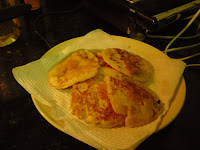Chinese greens
Whether they're stir-fried, gently steamed or added to soup, Chinese greens are an easy-to-prepare and nutritious addition to many meals.
Many Chinese greens are members of the crucifer family and have been cultivated since the fifth century. It has only been in the last decade or so that we have been introduced properly to them in mainstream greengrocers, and Australians have since embraced their use in many meals. Each vegetable has more than one name due to the different Chinese dialects, which can be confusing. Chinese greens are high in vitamins A and C, and are deliciously crunchy and nutritious when eaten raw or quickly stir-fried or steamed.
Varieties
Tatsoi: Has a mild flavour and can be used raw or cooked. Its leaves are darker and smaller than other Chinese greens and have distinctive long, white stalks.
Baby tatsoi: Leaves are used in salads and can be snipped straight from the punnet for a garnish.
Bok choy: Also known as pak choy or Chinese cabbage, it has dark-green leaves and a white stalk.
Baby bok choy: The most common Chinese green, it is light green and usually sold in bunches of three.
Choy sum: Produces small yellow flowers, which gives it its other name of Chinese flowering cabbage. Its long, pale stalks and fragile leaves are suited to stir-frying and steaming.
Hong Kong choy sum: This smaller variety has very thin stalks and is delicate in flavour.
Gai lan: Often referred to as Chinese broccoli. The best method of cooking is to quickly stir-fry or blanch to retain its crisp texture.
Chrysanthemum leaf: Featuring a taste similar to spinach, this green is a great addition to soups.
Buying and storing
- When buying, look for firm stalks that are bright in colour and blemish free. The leaves should be free of bruising or wilting.
- Store in plastic bags in the crisper section of the fridge to keep them fresh. They should then be used within three days of purchase.
- When preparing Chinese greens for cooking, cut off the base where the stalks join and separate the leaves for washing. Alternatively, greens such as baby bok choy can be cut in half and rinsed under cold running water.
Tips & facts
- Chinese greens pair well with soy sauce, oyster sauce, sesame oil, shaoxing wine, chicken, pork, seafood, garlic, ginger, chilli, noodles, rice, fermented soybeans, green onions, tofu, butter, Chinese five spice and Sichuan pepper.
- When cooking Chinese greens you don't have to use an Asian approach. They are also lovely sautéed in a little butter with fresh herbs, as you would cook other vegetables.
- Gai choy, has a distinctive mustard taste which is why it is also known as mustard green. Its flavour makes it perfect for pickling. Pickled vegetables are a great match for many Asian dishes.
- Chinese greens are best cooked quickly and at a high temperature. Blanch them quickly, stir-fry in a wok or steam. They should be cooked at the last minute.
- The Chinese love their greens so much, they eat on average one kilogram per day.






